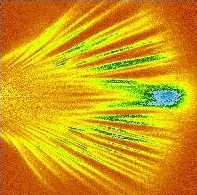Laser Plasma Interaction
Coordinator : Stefan Hüller

- Permanent staff :
Arnaud Couairon
Anne Héron (60 %)
- PhD students :
- Post-Doc :
- Senior Researcher (retired and/or emeritus) :
Jean-Claude Adam (60 %)
Patrick Mora
Denis Pesme
Research activities
The group “Interaction laser plasma” has three main research axes, all centred around the propagation and the interaction of laser pulses with plasmas and, more generally, with ionized non linear media. These axes are (1) “modelling of the interaction of complex laser beams with plasma waves in the context of inertial confinement fusion (i.e. laser fusion)”, (2) “interaction of intense and ultra-intense short laser pulses in plasmas and their applications”, and (3) “non linear light matter interaction at moderate laser intensities”.
(1) Modelling of laser-plasma interaction in the context of laser fusion
The activities of the group in the context of laser fusion are currently concentrated on the modelling of fundamental processes of laser-plasma coupling. Such processes take place in under-dense plasmas where the plasma waves and the plasma flow influence the propagation of the laser light that should be absorbed in order to achieve a symmetric implosion of the fusion capsule containing a D-T mixture. The wave-wave coupling provokes parametric instabilities, like stimulated scattering and light filamentation, which are deleterious for a good laser-plasma coupling. The understanding and the appropriate modelling of these instabilities is in the centre of our current efforts; the challenge is to be able to describe the laser propagation in the presence of these processes under the realistic conditions corresponding to the present day configurations of laser fusion experiments. Our main effort is focused on the proper description of the laser-plasma interaction in the case of several realistic laser beams giving rise to multiple couplings between the laser lights and plasma waves, such as energy transfer between crossed laser beams, “CBET”, with speckle structure, and collective laser plasma instabilities.
(2) Interaction of ultra-intense short laser pulses in plasmas and their applications
The coupling of ultra-intense laser pulses with dense plasmas is an important field of research, in particular with the access to PW-class lasers. It concerns both the comprehension of the transport of laser-generated relativistic electrons inside the plasma, as well as the acceleration mechanisms that emerge both from these fast electrons, namely ion (mostly proton) acceleration due to the charge separation field when supra-thermal electrons escape from the high-density target.
We have a strong simulation tool, our multi-dimensional collisional Particle-in-Cell code EMI2D, with which we can study both laser-plasma coupling, the particle transport, and the efficiency of acceleration schemes, both for electrons and ions. We are currently investigating how the acceleration efficiency can be improved by imprinted surface structure on the target interface. Due to the variety of possible imprints and their dynamics, the optimization of this process is currently a `hot topic'.
(3) Nonlnear light matter interaction at moderate laser intensities
We develop new models and numerical tools for understanding fundamental processes associated with laser-matter interaction at moderate intensities in the range from 1 to 100 TW/cm2, and femtosecond filamentation physics. In particular, our activity is focused on the generation of secondary radiation such as broadband super-continuum spectra and THz radiation. In parallel, we worked on applications of filamentation such as laser guided discharges, micro-machining of glasses with femtosecond laser pulses undergoing filamentation, atmospheric applications such as filament-based detection of pollutants, and the generation of underwater acoustic signals by femtosecond lasers.
Research convention
GDR "LEPICE" Lasers énergétiques et intenses et plasmas sous conditions extrêmes (Responsable : S. Hüller)
